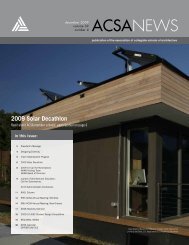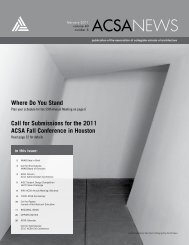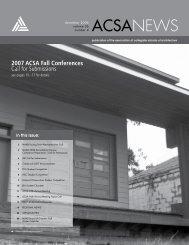digital aptitudes - Association of Collegiate Schools of Architecture
digital aptitudes - Association of Collegiate Schools of Architecture
digital aptitudes - Association of Collegiate Schools of Architecture
You also want an ePaper? Increase the reach of your titles
YUMPU automatically turns print PDFs into web optimized ePapers that Google loves.
SATURDAY, MARCH 3, 2012 - 12:30PM - 2:00PM<br />
Open Continued<br />
TWICC:Two-Way Insulating Composite Cladding<br />
Jefferson Ellinger, Rensselaer Polytechnic Institute<br />
Two-Way Insulating Composite Cladding is a customizable tile system<br />
that provides insulation to a facade with both the tile’s foam<br />
filled eco-resin fiberglass shell and an exterior layer <strong>of</strong> stagnant air<br />
generated by the surface geometry.<br />
Critical to the secondary insulate performance <strong>of</strong> the system is<br />
both the shape <strong>of</strong> the tile itself and the layout <strong>of</strong> a field <strong>of</strong> differentiated<br />
tiles. Careful articulations <strong>of</strong> both the tile and the field<br />
pattern are designed to create a rippled or textured surfaces. In<br />
this test case, a designed depth <strong>of</strong> 4 inches was used to generate a<br />
layer <strong>of</strong> stagnant air along the facade. This layer <strong>of</strong> stagnant air is in<br />
addition to the typical air film layer on the exterior surface <strong>of</strong> a wall<br />
and will act as another layer <strong>of</strong> insulation, much like the airspace<br />
in a wall cavity, retarding the thermal flows between interior and<br />
exterior. Testing is currently underway to determine the equivalent<br />
R-value; however, the initial C.F.D. (Computational Fluid Dynamic)<br />
analysis results verify the existence <strong>of</strong> a substantial stagnant air<br />
layer generated by the geometry at the building surface in both the<br />
2-D and 3-D simulations. This has been verified across a large range<br />
<strong>of</strong> air flow velocities and directions. We expect the value to be substantially<br />
greater than the R-value <strong>of</strong> 0.17 for an exterior air film and<br />
the air layer generated should achieve an R-value near 1.0. The primary<br />
insulation property is, <strong>of</strong> course, generated by the composite<br />
material assembly and has been calculated to achieve an R-value<br />
<strong>of</strong> approximately 7.0 yielding a combined R-value <strong>of</strong> nearly 8.0<br />
for the cladding system. When used in combination with a proper<br />
drainage plane, this substantially adds to the insulation capacity<br />
<strong>of</strong> the wall assembly at the most desirable position; the outermost<br />
level. A full scale mock up <strong>of</strong> the system has undergone weather<br />
testing and maintained positive water shedding under hurricane<br />
force conditions. The current iteration <strong>of</strong> the system shown here<br />
has recently been installed on a small structure for further field<br />
testing and verification.<br />
Equally as important to the insulation performance is the architectural<br />
effect and visual performance that is generated. In this installation,<br />
the designed pattern is constrained to using only six different<br />
tiles to expedite manufacturing, but this was clearly enough<br />
variation to generate a gradient visual pattern and dynamic play<br />
across the facade. The interplay between light and shadow give an<br />
unexpected depth to the wall surface, adding a substantial visual<br />
dynamic to the system at a very personal scale. The pigmentation<br />
is integral to the casting process. It is extremely durable and UV<br />
resistant allowing the project to maintain this look with minimal<br />
effort. The project shown represents a fine tuning <strong>of</strong> the system as<br />
a response to the local wind conditions balanced against maximizing<br />
the visual effects. Effects that reflect and re-contextualize the<br />
local landscapes through the seasons; summer and winter, buttes<br />
and moguls.<br />
Digital Apptitutes + Other Openings - Boston, MA - 51








